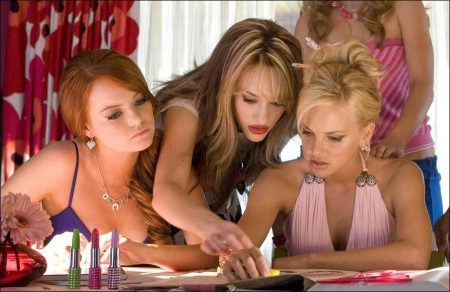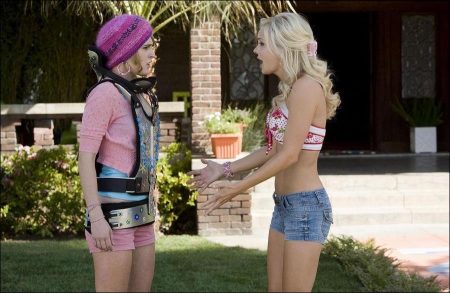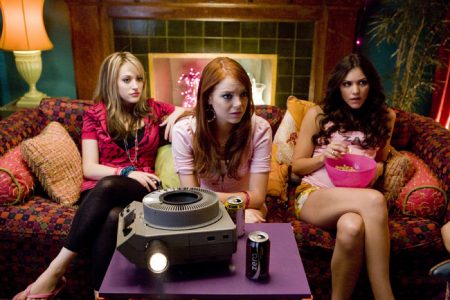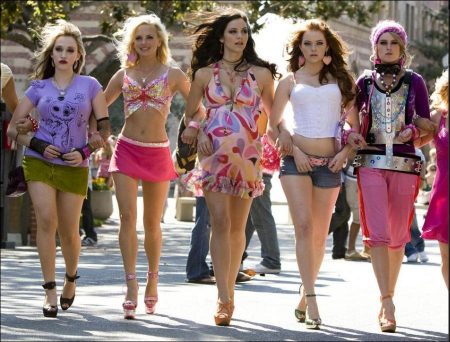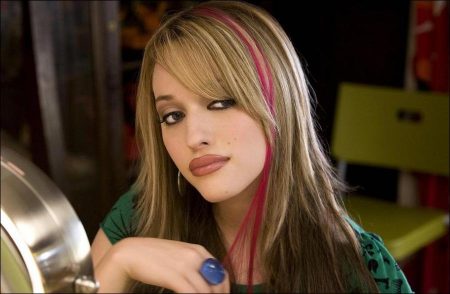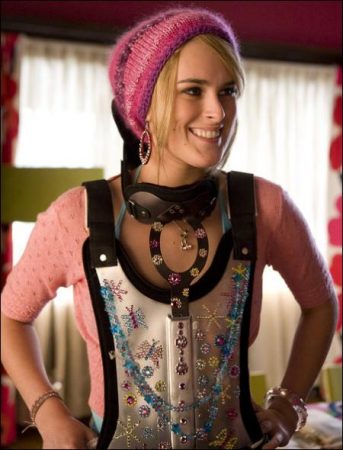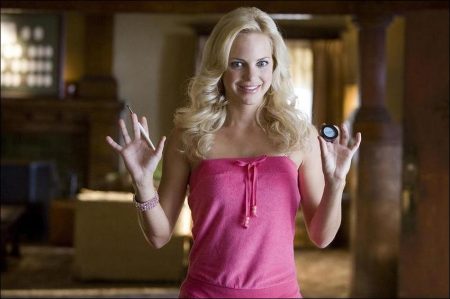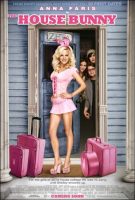Tagline: For the girls of ZETA house college life was no party, until Shelley showed up.
The House Bunny movie storyline. Shelley Darlington (Anna Faris) is an aspiring Playboy Playmate living the life of luxury in the Playboy mansion. The day after her twenty-seventh birthday, she awakes to find a note, seemingly from Hugh Hefner, asking her to pack up and leave. She happens to stumble upon a group of girls who remind her of herself: beautiful and fun. She follows them and sees that they live in luxury too. They turn out to be the Phi Iota Mu sorority, and snobbishly reject her when she tries to join them.
She makes her way down to the Zeta Alpha Zeta house, which appears to be far less luxurious than the first sorority she visited. The members of the Zeta house are dowdy, socially awkward, and caught off guard by Shelley’s bubbly nature, prompting them to initially reject her. Once they see Shelley’s ability to attract boys, the Zetas change their mind and take in Shelley as their new “house mother”, hoping that she can save them: their sorority is in danger of being shut down unless they can get thirty new pledges to join.
During her time spent with the Zetas, Shelley meets and becomes attracted to an intellectual, altruistic guy named Oliver (Colin Hanks), who works at a retirement home. Shelley goes out on a date with Oliver, and while her flirty tactics work with most guys, they fail with him, for he is a guy who actually wants to get to know Shelley rather than just sleep with her. To impress Oliver on their upcoming second date, Shelley starts attending classes and reading books, and tones down her appearance. The second date is also a disaster because she wears glasses that aren’t meant for her, and brings along note cards to help her sound smart.
Having gotten a makeover and lessons on how to attract guys and be popular, the Zetas throw a party, which is a huge success. Later, the Zetas are reviewing the girls who are hoping to pledge to Zeta, but their new popularity has made them conceited. When they realize what they’ve become, they blame Shelley—just as she returns from her unsuccessful date.
The House Bunny is a 2008 romantic comedy film directed by Fred Wolf, written by Kirsten Smith and Karen McCullah Lutz, and starring Anna Faris as a former Playboy bunny who signs up to be the “house mother” of an unpopular university sorority after finding out she must leave the Playboy Mansion.
On August 22, 2008, The House Bunny was released in the US. It debuted at #1 on its first day of release making $5.91 million, but ultimately landed in second place for its opening weekend, making $14.53 million, behind Ben Stiller’s action-comedy film Tropic Thunder, which made $16.2 million. The film had grossed $70 million worldwide ($48 million at the North American domestic box office and $22 million internationally) as of March 22, 2009. The film debuted in the UK chart at #1 grossing almost $1 million in its first weekend.
About the Film
“What happens to the people who have lived in the surreal Playboy Mansion world, where it’s parties and fun all the time? And why do they leave that world – do they get too old, or are they simply ready to move on to a different phase in their lives?” asks Anna Faris, the star of Columbia Pictures’ comedy The House Bunny, which focuses on Shelley, a Bunny who is facing that exact crisis.
Screenwriters Kirsten Smith and Karen McCullah Lutz – previously the screenwriters of the hit movie Legally Blonde – were, first and foremost, intrigued by the possibility of working with Faris. “We had just seen Just Friends and we both really enjoyed her performance in that movie,” says McCullah Lutz. “So we called and set up a meeting to have coffee.”
At the meeting, the writers and the star discussed an idea for the character of Shelley – the Playboy Bunny who changes her life. “Shelley has spent her whole adult life living in the Mansion, but when she gets booted out, she’s completely adrift. We took that idea and spent a few months ruminating over where she would land, and we finally came up with the idea that she should enter the world of a sorority – a misfit sorority that desperately needs her help,” says McCullah Lutz.
When Shelley first meets the girls, they are in danger of losing their house, due to a dearth of pledges. “Shelley has this idea that if she changes the Zetas into super hot girls, then they will be able to get guys – and if they can get guys, they can get pledges and keep their house,” Faris explains.
“She teaches the girls how to be cool and cute and popular – that’s definitely true – but for Shelley, it’s all about self-confidence,” McCullah Lutz continues.
But the Zetas are not the only ones who make transformations. At the beginning of the film, most people – including Shelley herself – see the Bunny as “just a Bunny.” According to McCullah Lutz, “Shelley defined herself as a Bunny and thought that was all she was capable of. She only defined herself in terms of her value as an object for male eyes. But then she learns she has more inherent talents and a bigger purpose in life than just being a Bunny.”
“It’s not just a message for girls, but everyone learning to accept themselves and love themselves for who they are,” says Faris. “When we first meet Shelley she may think she’s the hottest girl, but she learns to realize that how you look is not important – it’s about how you look at yourself.”
After Smith and McCullah Lutz worked out the story beats and the characters, they took their act on the road, pitching the story with Faris. “It was the best way to pitch. When you have the actual movie star in the room with you, the studio sees the movie coming alive. It’s much better than having them listen to Kirsten and I try to do the parts,” says McCullah Lutz.
The trio landed in the office of producer Heather Parry, who works at Happy Madison Productions. Parry – a fan of Faris and of the Legally Blonde writers – liked the idea and took it to Adam Sandler and his producing partner Jack Giarraputo. They had already worked with Faris on the comedy The Hot Chick and were huge fans of the actress, and brought it to their home studio at Columbia Pictures.
Parry says that although The House Bunny is Happy Madison’s first female-driven comedy, it shares the same underlying comedy goal. “It’s funny and it has heart,” Parry says. “Every girl goes through a time in her life in which she tries on new looks and new attitudes – and The House Bunny looks at that time in a really funny and charming way.”
To direct the film, the producers tapped Fred Wolf. Producer Allen Covert says that the Happy Madison team had known Wolf for years, since he had written for Sandler at “Saturday Night Live.” “You might not think that Fred would be the type of director to helm this female-driven comedy, but when he was at ‘SNL’ he transitioned from the Sandler-Farley-Spade-Schneider years into the Molly Shannon-Cheri Oteri years – all of a sudden, that show had a lot of women cast members. Fred’s strength as a director for this film was his background writing for and working with female comedians.”
About the Characters
To play the hapless sorority sisters of Zeta Alpha Zeta, the filmmakers turned to a group of young stars on the rise.
At the center of the group is Natalie, the president of the sorority. Though Natalie is super-smart, she’s also more than a little clueless. She likes boys, and she wants boys to like her, too, but she has no idea how to approach the opposite sex, or, once she approaches, what to say.
Emma Stone, who had a co-starring role in last summer’s hit Superbad, takes on the role. She says, “Natalie might be a little uncomfortable, but she has a heart of gold – and she certainly sees through Shelley’s bunny exterior to understand Shelley’s heart very well. They end up becoming close friends because of what they see in each other.”
Parry notes, “We’d just seen an early screening of Superbad, so we were excited to have Emma come in and audition. She first read for one of the Phi Iota Mu girls, and then read the part of Harmony. Only after she left did we think, ‘You know, she’d be great as Natalie.’ She’d already left the Sony lot, so we made her turn around and come back. She was nervous – she’d parked somewhere restricted and the whole time was afraid that her car was going to get towed. It worked out for her – she got the part.”
“It was fun to undergo the transformation, from the grays and navies that Natalie wears at the beginning, to the hair extensions and makeup and fun costumes,” says Stone. “Of course, the characters also come to realize that though all that stuff fits the look that Shelley likes, it’s not really who they are.”
Natalie’s sorority sister, Mona, is just about the last person who you’d think would make that transformation. She has multiple piercings and adopts a very women’s-studies vibe, and signs on to Shelley’s plan more for the opportunity to conduct a sociological experiment than to become popular.
There was one and only one person who the filmmakers considered for the role. Kat Dennings played the part during an early table read at a time when the only other actor cast was Anna Faris. She was so great at the table read that the producers stopped looking.
Dennings knew the character immediately. “Mona has an issue with males,” Dennings deadpans. “They make her very uncomfortable and she makes them very uncomfortable – mostly because she goes around wearing shirts that say ‘legalize castration.'”
Making her motion picture debut in The House Bunny is singer Katharine McPhee. Her character, Harmony, is a very pregnant, and very flower-child, sorority sister. She is always seeing the best in people and always being shocked by how cruel others can be sometimes. As she prepares to give birth, Harmony is the classic beautiful-on-the-inside type who flowers when Shelley begins her lessons.
For her part, McPhee sees the character a little differently. “She’s supposed to be this hippie chick, but I think she’s just free-spirited, which is definitely a side to my personality,” she says. “Katharine McPhee is obviously a great singer,” enthuses writer McCullah Lutz, “but she’s a good actress, too.”
McPhee couldn’t resist the chance to show off her pipes during a karaoke scene in the film. “I knew that the scene couldn’t be like it was me singing,” she laughs, “but Harmony is a free spirit, willing to try anything, and excited about life, and I think she’d definitely belt out the song to the best of her ability.”
McPhee was also thrilled by the chance to sing for the film – a new version of the 80s pop anthem “I Know What Boys Like,” which plays over the end credits. “I had a great time recording the song,” she says, “but to be honest – shooting the movie was even better.”
To play the role of Joanne, a shy girl in a back brace, the filmmakers looked to a member of the next generation of Hollywood’s A-list: Rumer Willis.
“Joanne has always hidden behind her brace,” says Willis. “Even though she doesn’t need it anymore, it’s kept her from having to show the world her true self.”
“Talk about physical comedy,” Covert gushes. “Rumer just ran with it the minute she found out she was going to be that person. She took the brace as a prop and used it to find the comedy and become that character.”
“That brace was like my purse for eight weeks – it went everywhere I went,” Willis says. “At one point, we were rehearsing – I was lying on a blanket, and I couldn’t stand up. Fred comes over, and goes ‘Are you serious or are you just kidding?'” the actress laughs. “I was like a turtle on its back, arms waving helplessly, until somebody helped me up.”
Faris says that as filming continued, each of the girls naturally fell into the roles of the characters they were playing in the film. “I felt like a house mom,” she says. “I was a little concerned initially that maybe with all the girls, some of them wouldn’t get along, but everyone really did seem to love each other and everyone brought their own uniqueness to the table.”
Heather Parry agrees. “They all championed one another, which can sometimes be rare in Hollywood. While we were shooting the film, Emma Stone had Superbad coming out and the girls went to the premiere to surprise her. They all became fast friends and really supportive of one another. It was the greatest thing to see.”
The seven sisters of Zeta House are not the only ones to get a makeover. While Shelley’s mission is to transform the dowdy damsels in distress into glamour girls, the girls help Shelley with her own transformation when she meets a guy unlike any she has ever met before. Colin Hanks takes the role of Oliver, the sweet-natured administrator of a nursing home. “Shelley instantly falls for Oliver’s kindness and his charm. I always imagine that she never met anybody like that. He’s not the kind of guy that hangs out at the Playboy Mansion.”
And Oliver had never met anyone quite like Shelley. Hanks says, “They go on a series of dates that don’t really go very well because Shelley is constantly trying to impress Oliver. First she’s playing the hard-to-get girl, and that doesn’t really impress him. She tries to be the super-smart-bookworm, and that doesn’t impress him. What impresses him is when she starts just being herself. He sees something in Shelley that is cute and endearing and special. The way that Oliver sees her is not the way that most people see her.”
Making his motion picture debut in The House Bunny is Tyson Ritter, lead singer of the band The All-American Rejects. Ritter takes on the role of Colby, the object of Natalie’s affections from afar. He describes his involvement with the film this way: “Eight beautiful women every day for two weeks. Paradise!”
The Zetas are rounded out by Dana Goodman as Carrie Mae, Kimberly Makkouk as Tonya, and Kiely Williams as Lily. Also joining the cast are Beverly D’Angelo as Mrs. Hagstrom, the house mother of Phi Iota Mu, the Zetas’ rival sorority, and Christopher McDonald as Dean Simmons.
The House Bunny is a tale of two houses – the drab, dreary Zeta House vs. the fantasy-life-come-true of the Playboy Mansion. Creating and juxtaposing these two worlds largely depended on the production and costume designers, Missy Stewart and Mona May.
“The characters go through such transitions that there were clear demarcations,” says production designer Missy Stewart, who previously designed the films Legally Blonde, 21, and many others. “The first part of the script developed our main character Shelley and her fall from grace from the Playboy Mansion and her attempt to enter the ‘real’ world. I like to think of it as her paradise lost period. So we tried to create paradise in the first act in every way.”
The producers scored a huge coup when Alta Loma Entertainment, a subsidiary of Playboy Enterprises, Inc. and producers of “The Girls Next Door,” secured Hugh Hefner’s participation in the filming and opened up the legendary Playboy Mansion to the production.
“We wrote it all into the script but we didn’t know if Playboy was actually going let us use the name and the Mansion,” says writer McCullah Lutz. “So we didn’t go there or do any research.” So just how did they characterize the bunnies within? “We just figured that’s what bunnies were like. It wasn’t too hard to come up with. You see a lot of them wandering around Los Angeles.”
While the lifestyle of the Playboy Mansion is known throughout the world, relatively few people have been past the gates. It was a first-time experience for the cast and crew. “It was one of the most surreal experiences I’ve ever had,” says Faris.
Producer Allen Covert was also astonished. “Hef was awesome. We got to shoot in his bedroom. I sat on his bed. Then I got nervous – I thought, ‘Is he gonna know that I sat on his bed? Are we gonna get thrown out of here because I’m sitting on his bed?'” the producer laughs.
Misplaced paranoia aside, the company had a great time at the Mansion. “We were so thankful that Hef let us use the Mansion to shoot,” McCullah Lutz beams. “It’s just a bonus that he’s playing himself.”
Contrasted with the Mansion is the Zeta House – the home that the sorority is so desperate to keep. The structure itself goes through the same character arc as the girls living within – starting unloved and neglected, but with good bones.
“We had a great task: to find a great old house that was a wreck,” says Stewart. They found their home, but had their work cut out for them. “It was such a wreck that we had to bring it up to make it look like a livable wreck,” Stewart says. “The yards were overgrown, there was no lawn, there was no backyard. The windows were falling apart. We even had to rebuild part of the house to shoot in it. The inside was so stained and messy that it required paint and re-aging and then removing all the carpet and fixing the floors and then re-aging those. So it was kind of a backwards process. But the house had such great bones that we knew we had a winner – it went through that transition really smoothly.”
After shooting at the West Adams house for two weeks, the production moved to other locations for one week as Stewart and her team fixed up the place. During that week, Stewart’s team put in lawns, flowers, new windows, painted, reupholstered furniture, and hung drapes. “We decorated the house in the Zeta colors – pinks and teals and oranges. It became a very lively place,” says Stewart. “It was fun to see the house go through that transformation. I knew Mona was going to go crazy with the costumes as the girls go through their makeover, so I wanted to give her a nice palette that wouldn’t compete with the costumes for attention. It’s quiet and colorful.”
“I’m a colorist,” explains costume designer Mona May, who previously designed costumes for the films Clueless and Enchanted. “I work with color and it’s very important in my work. I was working very closely with the production designer Missy to make sure that everything goes together.”
“What happens in a movie like this when you have so many girls, you have to worry who’s wearing what,” May continues. “What color are they wearing? Are they going to go together in the clothing that they’re wearing? You only have so many colors in the color wheel. So if there’s already pink and yellow and blue, you want to make sure nobody’s wearing the same color and the patterns are not clashing.”
May set out to define each character and each character’s transition. “The wardrobe very much supports that transformation. With Fred we worked very closely to make sure the character stays true to the whole film even as they’re transforming from one look to another. The punk girl always stays punk. The hippie girl always stays hippie.”
With eight leading characters, the volume of clothing, shoes and accessories alone was head-spinning, requiring two wardrobe trailers. “It was really fun to work with that many girls,” May goes on, “I think that each one of the Zetas has about 30 changes. Anna had about 50 changes. So it’s about 300 changes that I dealt with on this show. Fantastic craziness. Fred stayed away from our trailer,” the designer winks.
The final creation of the character Shelley nearly rendered Faris unrecognizable. Parry says that to play the role, Faris was fully committed as an actress. “She was so disciplined,” she says. “She was in perfect shape and a driving force in creating the look of the character. She was willing to do whatever it took to bring Shelley alive.”
In fact, Faris spent more than three hours every day between the make-up and wardrobe trailers to get into character. Faris relates, “There’s all kinds of hair up here that isn’t mine. Padding here that’s not mine, and tons of wardrobe fittings. I’ve got fake hair, fake chest, fake tan – but Shelley’s heart is real.” Then there is the matter of those insane shoes. “Shelley likes to wear heels,” the actress continues, “Some of the shoes are around 7 or 8 inches high. In fact, there was one scene I couldn’t wear my high heels and it threw me for a loop — I was totally unnerved. I felt like I couldn’t play Shelley properly.”
For many of the other girls getting into character was, “All about bras and bra pads,” jokes May. “I’ve never been on a show where I’ve had so many bras.”
“Mona May did an amazing job,” says Rumer Willis. “I wouldn’t really notice until we would be on set or I’d see some pictures of us together, of how much thought goes into it and every day. We would wear different colors but the color palette of all of us together – it’s amazing to see how that all works out.”
Once Shelley’s makeover of the Zeta girls is complete, they decide to make their college social debut with an Aztec party. “When I interviewed with Fred, he told me he wanted to make a volcano out of Jell-O. I laughed because I knew that was impossible,” laughs Stewart. “But I did have this idea that we could make a fairly credible volcano out of foam, a pool of Daiquiri mix where the girls would land, add some steam, and them make a huge caldera of Jell-O. So we started testing Jell-O weeks before we shot. Fred added a slide. We just went crazy with it. It wound up being so tribal it was like an Aztec rave – there were drummers and music and torches and smoke. It worked out perfectly.”
McCullah Lutz was impressed. “On the day we shot the Aztec party, we were looking at a volcano that was about 800 times bigger than we imagined when we wrote it. We pictured a little paper mâché structure with some Jell-O coming down the sides – they gave us this three-story epic structure. It was pretty fun to see it come to life. Actually, I’m hoping that we start a trend. I want to go to some random college party in a couple of years and see them have a volcano where they sacrifice a virgin,” the writer laughs.
“I like to think of the Aztec party as them being the climax of the second act, because they’ve gone as far as they can in that direction,” says Stewart. Not long after the party, the Zetas do decide that they’ve turned into Shelley’s vision of the perfect girls, but not their own.
“There is another transformation for them to go through,” says May. “Fred wanted to make sure that we really find the essence of the girls in their last change. What happens is they really find themselves. So we asked ourselves, Who are they now? What is the meaning of the film and the way the clothing supports that?”
Shelley also transforms. “You really are starting as this very cartoon-y character,” the designer says of Shelley. “We specifically made the clothes very cartoon-y with bubblegum colors, plastic jewelry, big hair and it’s all about pink and bright blue and shiny objects pointing to your breasts. As she goes through this transformation, we strip the bling off of her and start covering her up a little bit more.”
The House Bunny (2008)
Directed by: Fred Wolf
Starring: Anna Faris, Emma Stone, Rumer Willis, Kat Dennings, Sarah Wright, Dana Goodman, Colin Hanks, Beverly D’Angelo, Christopher McDonald, Katharine McPhee, Kiely Williams
Screenplay by: Karen McCullah Lutz
Production Design by: Missy Stewart
Cinematography by: Shelly Johnson
Film Editing by: Debra Chiate
Costume Design by: Mona May
Set Decoration by: Tracey A. Doyle
Art Direction by: John Chichester
Music by: Waddy Wachtel
MPAA Rating: PG-13 for sex-related humor, partial nudity and brief strong language.
Distributed by: Columbia Pictures
Release Date: August 22, 2008
Views: 149
